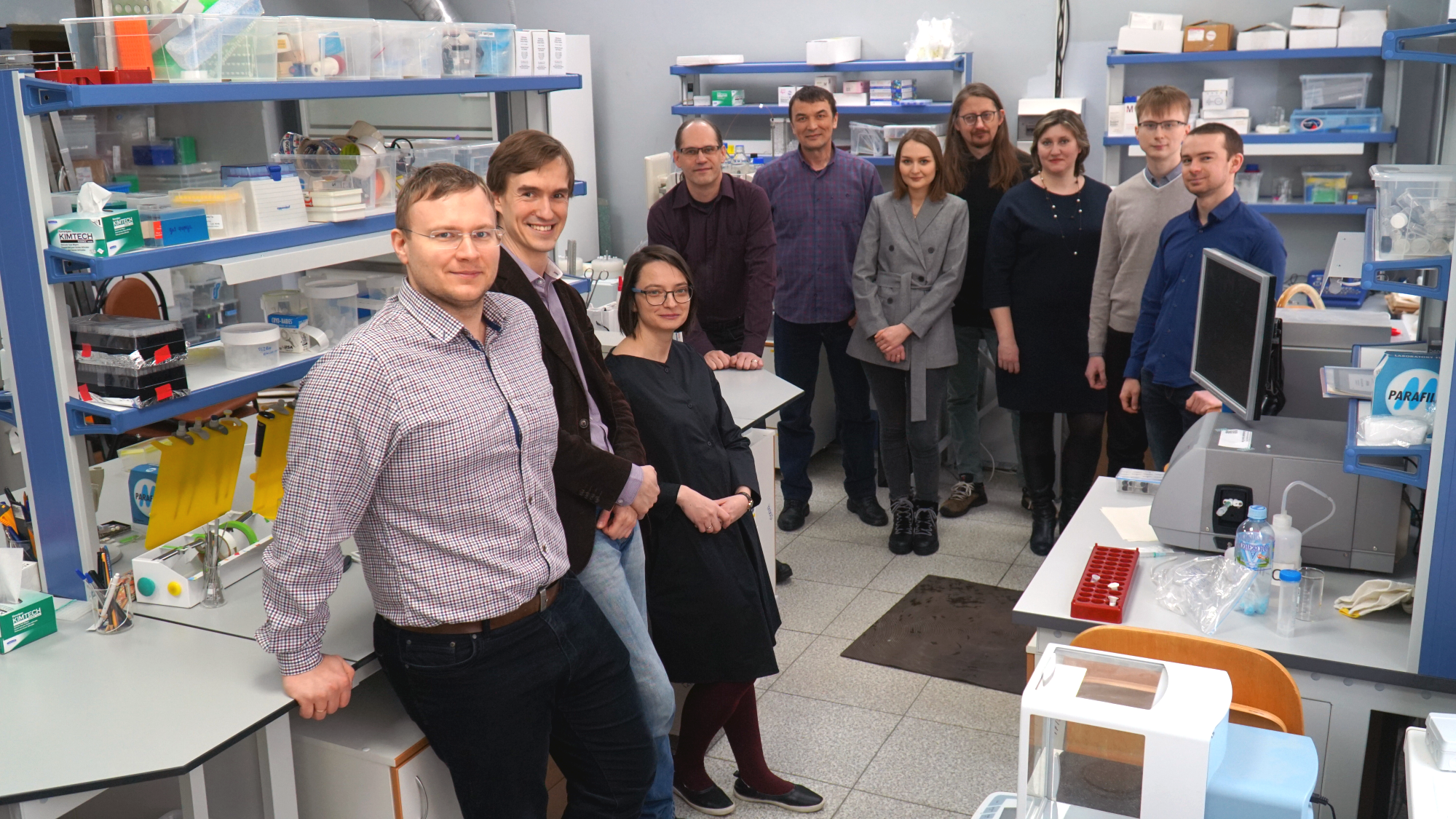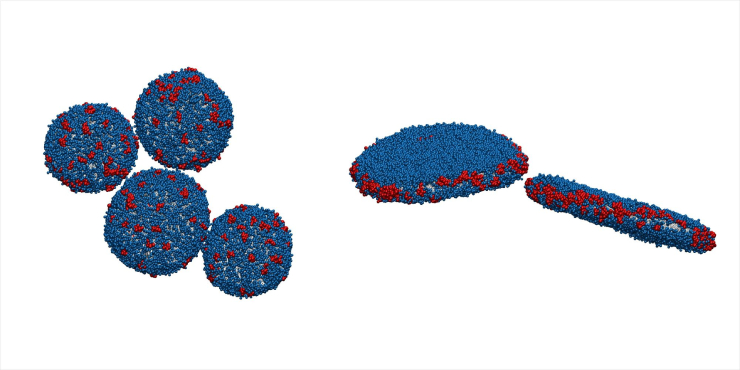In search of causes of Alzheimer’s disease: JINR scientists recorded temperature effect on structure of cell membrane
News, 16 June 2023
A new cycle of the Alzheimer’s disease study has begun with the development of modern experimental techniques and effective detection tools. Today, this severe neurodegenerative disease is an urgent problem all over the world. Alzheimer’s disease is called the most common type of dementia affecting the elderly. Currently, there are no effective drugs for this disease. Any treatment is almost impossible due to the diagnosis in the late stages, as well as the lack of an unambiguous understanding of the aetiology of the disease. In this regard, the study of the fundamental mechanisms of the occurrence of Alzheimer’s disease is becoming very important.
Since 2019, JINR scientists have been studying the properties of cell membranes and cellular interactions, taking as a basis one of the most common theories of the occurrence of Alzheimer’s disease, i.e. amyloid beta one. This theory is based on the fact that amyloid-beta peptide can form so-called amyloid plaques consisting of clusters of peptide folded in the form of fibrils in the brain of a patient suffering from Alzheimer’s disease. It eventually leads to the breakage of cell membranes and the death of neurons.
 Group of JINR scientists who carried out research
Group of JINR scientists who carried out research
At first, the group aimed to study the “behaviour” of amyloid-beta peptide embedded in the membrane, depending on its rigidity. At the same time, scientists used a low concentration of amyloid-beta peptide to prevent the fibril formation. The group found out that cholesterol and melatonin can control the rigidity of the cell lipid membrane during the research that the group conducted in 2019-2020. “The presence of cholesterol caused a noticeable increase in the thickness of the model membrane. Cholesterol regulated the hydrocarbon tails of lipids and lengthened them, which increased the thickness and the viscosity of the membrane,” Deputy Director for Scientific Work of the Laboratory of Neutron Physics, Head of the scientific group Norbert Kučerka says. “The effect of melatonin, which reduces the thickness of the membrane and lowers its viscosity, is connected with the disordering of lipid tails. Melatonin molecules were localised in the area of phospholipid heads and led to an increase in the distance between them.”
In the course of experiments with cholesterol and melatonin, scientists noticed that temperature affects the structure of the model membrane in the presence of amyloid-beta peptide, namely, unilamellar vesicles, which are a spherical shell consisting of a lipid bilayer. The results of the next stage of the research, based on data from an experiment conducted in 2021, confirmed this observation and allowed scientists to detect an interesting effect. With a decrease in temperature and the transition of lipids, which make up the model membrane, into the gel phase, there was “breakage” of the membrane, i.e. the decay of vesicles into bicelle-like structures (flat disc-shaped structures from one lipid bilayer), but only in the presence of amyloid-beta peptide. In the absence of the peptide, the membrane remained intact.
 Self-organizing structures of small single-layer vesicles and disks after modeling. Lipid chains are coloured grey, lipid head groups are blue, and the Aß(25-35) molecules are red. Water molecules are hidden for better visualisation.
Self-organizing structures of small single-layer vesicles and disks after modeling. Lipid chains are coloured grey, lipid head groups are blue, and the Aß(25-35) molecules are red. Water molecules are hidden for better visualisation.
The work done within the research was highly appreciated and received the JINR Second Prize in the 2022 Applied Physics Research category.
“Changes in the physical and chemical properties of the cell membrane as a result of the phase transition do not by themselves lead to its breakage. However, interaction with additional components can lead to abrupt structural changes. In our research, we have documented that such changes triggered by the presence of amyloid-beta peptide occur during phase transitions. We used the method of small-angle neutron scattering at the IBR-2 Reactor of FLNP JINR, which is perfect for the study of disordered systems such as lipid membranes, since methods based on crystallography do not work in such cases. The curves of small-angle neutron scattering demonstrated the destructive effect of amyloid-beta peptide on the model membrane system. Under the influence of temperature and in the presence of a peptide, the shape of the model system changes from large vesicles to small vesicles and bicelle-like structures,” Alexander Ivankov, one of the authors of the work, an FLNP JINR senior researcher, said.
Scientists note that the observed effect of peptide fragmentation on the membrane may be a key aspect for understanding the role of membrane-peptide interactions in Alzheimer’s disease. “Now we need to understand how and why this is happening. And when we find a mechanism in our simple model system, we will complicate it, study various theories and test them. In fact, our research is of a fundamental level. Our results have no direct application, but they have the potential to become applied ones and be used in pharmacology and areas related to human health,” Norbert Kučerka concluded.
References
- O. Ivankov, T. Kondela, E. Dushanov, E. Ermakova, T. Murugova, D. Soloviov, A. Kuklin, N. Kučerka; Cholesterol and melatonin regulated membrane fluidity does not affect membrane’s breakage triggered by amyloid-beta peptide. Biophysical Chemistry 298 (2023) 107023:1-8
- Oleksandr Ivankov, Dina R. Badreeva, Elena V. Ermakova, Tomáš Kondela, Tatiana N. Murugova, Norbert Kučerka; Anionic lipids modulate little the reorganization effect of amyloid-beta peptide on membranes. General Physiology and Biophysics 42/1 (2023) 59-66
- Tomáš Kondela, Pavol Hrubovčák, Dmitry Soloviov, Dina Badreeva, Tatiana Murugova, Vadim Skoi, Alexander Kuklin, Olexander Ivankov, Norbert Kučerka; Approaches for a Closer Look at Problems of Liquid Membranes with Amyloid-Beta Peptides. in Soft Matter Systems for Biomedical Applications, edited by Leonid Bulavin and Nikolai Lebovka. Springer (2022)
- O. Ivankov, T.N. Murugova, E.V. Ermakova, T. Kondela, D.R. Badreeva, P. Hrubovčák, D. Soloviov, A. Tsarenko, A. Rogachev, A.I. Kuklin, N. Kučerka; Amyloid-beta peptide (25-35) triggers a reorganization of lipid membranes driven by temperature changes. Scientific Reports 11 (2021) 21990:1-9
- Pavol Hrubovčák, Ermuhammad Dushanov, Tomáš Kondela, Oleksandr Tomchuk, Kholmirzo Kholmurodov and Norbert Kučerka; Reflectometry and molecular dynamics study of the impact of cholesterol and melatonin on model lipid membranes.European Biophysics Journal 50 (2021) 1025-1035
- Ivankov O., Ermakova E., Murugova T., Badreeva D., Dushanov E., Kondela T., Kholmurodov Kh., Kuklin A., Kučerka N.; Interactions in the model membranes mimicking preclinical conformational diseases in Advances in Biomembranes and Lipid Self-Assembly, edited by Ales Iglic, Ana García Sáez, Michael Rappolt. Elsevier (2020)
- Murugova T., Ivankov O., Ermakova E., Kondela T., Hrubovčák P., Skoi, V., Kuklin A., Kučerka N.; Structural changes introduced by cholesterol and melatonin to the model membranes mimicking preclinical conformational diseases.General Physiology and Biophysics 39/2 (2020) 135-144